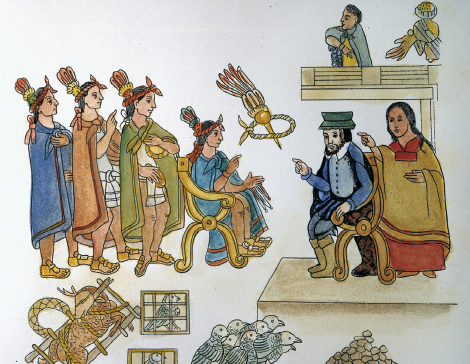Individuals in Society: Doña Marina / Malintzin

In April 1519 Hernán Cortés and his followers received a number of gifts from the Tabasco people after he defeated them, including a group of twenty female captives. Among them was a young woman the Spanish baptized as Marina, which became Malin in the Nahuatl (NAH-
Marina possessed unique skills that immediately caught the attention of Cortés. Fluent both in Nahuatl and Yucatec Maya (spoken by a Spanish priest accompanying Cortés), she offered a way for him to communicate with the peoples he encountered. She quickly learned Spanish as well and came to play a vital role as an interpreter and diplomatic guide. Indigenous pictures and writings created after the conquest depict Malintzin as a constant presence beside Cortés as he negotiated with and fought and killed Amerindians. The earliest known images show her interpreting for Cortés as he meets with the Tlaxcalan lord Xicotencatl, forging the alliance that would prove vital to Spanish victory against the Aztecs. Malintzin also appears prominently in the images of the Florentine Codex, an illustrated history of the Aztec Empire and its conquest created near the end of the sixteenth century by indigenous artists working under the direction of Friar Bernardino de Sahagún. All the images depict her as a well-
Malintzin bore Cortés a son, Don Martín Cortés, in 1522 and accompanied him on expeditions to Honduras between 1524 and 1526. It is impossible to know the true nature of their personal relationship. Cortés was married to a Spanish woman in Cuba at the time, and Malintzin was a slave, in no position to refuse any demands he made of her. Cortés recognized their child and provided financial support for his upbringing. Malintzin later married one of Cortés’s Spanish followers, Juan Jaramillo, with whom she had a daughter. It is unknown when and how she died.
Bernal Díaz gave Malintzin high praise. In his history, written decades after the fact, he described her as beautiful and intelligent, revered by native tribesmen, and devotedly loyal to the Spanish. He stated repeatedly that it would have been impossible for them to succeed without her help. Cortés mentioned Malintzin only twice in his letters to Spanish king Charles V. He acknowledged her usefulness as his interpreter but described her only as “an Indian woman of this land,” giving no hint of their personal relationship. No writings from Malintzin herself exist.
Malintzin is commonly known in Mexico and Latin America as La Malinche, a Spanish rendering of her Nahuatl name. She remains a compelling and controversial figure. Popular opinion has often condemned La Malinche as a traitor to her people, whose betrayal enabled the Spanish conquest and centuries of subjugation of indigenous peoples. Other voices have defended her as an enslaved woman who had no choice but to serve her masters. As the mother of a mestizo (mixed-
QUESTIONS FOR ANALYSIS
- Why was the role of interpreter so important in Cortés’s conquest of the Aztec Empire? Why did Malintzin become such a central figure in interactions between Cortés and the Amerindians?
- What options were open to Malintzin in following her path? If she intentionally chose to aid the Spanish, what motivations might she have had?

DOCUMENT PROJECT
How did Spanish and Amerindian artists depict Malintzin? Examine Spanish and Amerindian representations of Malintzin’s role in the conquest, and then complete a quiz and writing assignment based on the evidence and details from this chapter. See Document Project for Chapter 16